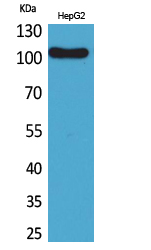CD307 Polyclonal Antibody
- Catalog No.:YT5268
- Applications:WB;IHC;IF;ELISA
- Reactivity:Human;Mouse
- Target:
- CD307
- Gene Name:
- FCRL5
- Protein Name:
- Fc receptor-like protein 5
- Human Gene Id:
- 83416
- Human Swiss Prot No:
- Q96RD9
- Mouse Swiss Prot No:
- Q68SN8
- Immunogen:
- The antiserum was produced against synthesized peptide derived from the Internal region of human FCRL5. AA range:191-240
- Specificity:
- CD307 Polyclonal Antibody detects endogenous levels of CD307 protein.
- Formulation:
- Liquid in PBS containing 50% glycerol, 0.5% BSA and 0.02% sodium azide.
- Source:
- Polyclonal, Rabbit,IgG
- Dilution:
- WB 1:500 - 1:2000. IHC: 1:100-300 ELISA: 1:20000.. IF 1:50-200
- Purification:
- The antibody was affinity-purified from rabbit antiserum by affinity-chromatography using epitope-specific immunogen.
- Concentration:
- 1 mg/ml
- Storage Stability:
- -15°C to -25°C/1 year(Do not lower than -25°C)
- Other Name:
- FCRL5;FCRH5;IRTA2;Fc receptor-like protein 5;FcR-like protein 5;FcRL5;BXMAS1;Fc receptor homolog 5;FcRH5;Immune receptor translocation-associated protein 2;CD307e
- Observed Band(KD):
- 110kD
- Background:
- This gene encodes a member of the immunoglobulin receptor superfamily and the Fc-receptor like family. This gene and several other Fc receptor-like gene members are clustered on the long arm of chromosome 1. The encoded protein is a single-pass type I membrane protein and contains 8 immunoglobulin-like C2-type domains. This gene is implicated in B cell development and lymphomagenesis. Alternatively spliced transcript variants encoding different isoforms have been identified. [provided by RefSeq, Sep 2010],
- Function:
- disease:A chromosomal aberration involving FCRL5 is found in Burkitt lymphoma (BL) cell lines with 1q21 abnormalities [MIM:113970]. Duplication dup(1)(q21q32).,domain:Contains 2 copies of a cytoplasmic motif that is referred to as the immunoreceptor tyrosine-based inhibitor motif (ITIM).,function:May be involved in B-cell development and differentiation in peripheral lymphoid organs and may be useful markers of B-cell stages. May have an immunoregulatory role in marginal zone B-cells.,similarity:Contains 8 Ig-like C2-type (immunoglobulin-like) domains.,tissue specificity:Expressed in marginal zone B-cells, immunoblasts, tonsillar germinal center centrocytes and in the intraepithelial and interfollicular regions of the tonsil. Expressed in many lymphoma cell lines and on hairy cell leukemia cells. Isoform 1, isoform 3, isoform 4 and isoform 5 are detected in lymph node, spleen, bone marro
- Subcellular Location:
- Cell membrane ; Single-pass type I membrane protein .
- Expression:
- Expressed in marginal zone B-cells, immunoblasts, tonsillar germinal center centrocytes and in the intraepithelial and interfollicular regions of the tonsil. Expressed in many lymphoma cell lines and on hairy cell leukemia cells. Isoform 1, isoform 3, isoform 4 and isoform 5 are detected in lymph node, spleen, bone marrow, and small intestine with preponderance of isoform 3. Expressed in mature and memory B-cells and down-regulated in germinal center cells (at protein level).
- June 19-2018
- WESTERN IMMUNOBLOTTING PROTOCOL
- June 19-2018
- IMMUNOHISTOCHEMISTRY-PARAFFIN PROTOCOL
- June 19-2018
- IMMUNOFLUORESCENCE PROTOCOL
- September 08-2020
- FLOW-CYTOMEYRT-PROTOCOL
- May 20-2022
- Cell-Based ELISA│解您多样本WB检测之困扰
- July 13-2018
- CELL-BASED-ELISA-PROTOCOL-FOR-ACETYL-PROTEIN
- July 13-2018
- CELL-BASED-ELISA-PROTOCOL-FOR-PHOSPHO-PROTEIN
- July 13-2018
- Antibody-FAQs
- Products Images

- Western Blot analysis of HepG2 cells using CD307 Polyclonal Antibody. Secondary antibody(catalog#:RS0002) was diluted at 1:20000
.jpg)
- Immunohistochemical analysis of paraffin-embedded human-brain, antibody was diluted at 1:100



